Mercedes-Benz S-Class
| Mercedes-Benz S-Class | |
|---|---|

The latest generation of the S-Class, W222
| |
| Overview | |
| Manufacturer | Mercedes-Benz |
| Production | Predecessors date to mid-1950s S-Class nomenclature adapted in 1972 |
| Assembly | Sindelfingen, Germany Pune, India[1] |
| Body and chassis | |
| Class | Full -size luxury car (F) |
| Body style | 4-door sedan 2-door coupé |
| Related | Mercedes-Benz CL-Class Mercedes-Benz GL-Class |
| Chronology | |
| Predecessor | Mercedes-Benz Type 300 |
The Mercedes-Benz S-Class, formerly known as Sonderklasse (German for "special class"), is a series offlagship vehicles produced by the German automaker Mercedes-Benz, a division of German company Daimler AG. The classification was officially introduced in 1972 with the W116 S-Class, which succeeded previous Mercedes-Benz models dating to the mid-1950s. The S-Class has served as the top model for Mercedes for over fifty years in its various incarnations. The S-Class has debuted many of the company's latest innovations, including drivetrain technologies, interior features, and safety systems (such as the first seatbelt pretensioners).[2] The S-Class has ranked as the world's best-selling luxury sedan,[3] and its latest generation, the W222 S-Class, premiered in 2013. As in previous iterations, the W221 S-Class is sold in standard- and long-wheelbase versions; I4, V6, V8, V12, dieseland hybrid powertrains are offered. All models built in Mexico or sold in the United States are only available in long wheelbase.
"S-Class" is the anglicized version of "S-Klasse," an abbreviation of the previously mentioned Sonderklasse. In automotive terms it refers to "a specially outfitted car." Although used colloquially for decades, following its official application in 1972, six generations of officially named S-Klasse sedans have been produced. Previous two-door coupe models of the S-Class were known as SEC and later S-Coupe. In 1998 the S-Class coupe was spun off in a separate line as the CL-Class, however as of June 2014, it has been re-designated as the S-Class Coupé for the 2015 model year, doing away with the CL-Class.
Model nomenclature
| Chassis | Type | Debut |
|---|---|---|
| W180 | "Ponton" | 1954 |
| W128 | "Ponton" | 1958 |
| W111 | "Fintail" | 1959 |
| W112 | "Fintail" | 1959 |
| W108 | N/A | 1965 |
| W116 | S-Class | 1972 |
| W126 | S-Class | 1979 |
| W140 | S-Class | 1991 |
| W220 | S-Class | 1999 |
| W221 | S-Class | 2005 |
| W222 | S-Class | 2014 |
In 1993, when the W202 was introduced as C-Class, the traditional naming convention (numbers, plus letters) was reversed, with a leading letter identifying the line (As of late 2015, A, B, C, CLA, CLS, E, G, GL, GLA, GLC, GLE, S, SL, SLK, and V are in use). From then on, the long-wheelbase models (formerly "SEL") and the regular-length models (formerly "SE") are both labeled with the prefix of "S" regardless of length. For example, both 500SE and 500SEL are now labeled as S500/S500L, with fuel injection being standard by now anyway. The W221 S-Class has been available in four trim levels; the numbers are given in ascending order to denote more upscale models (e.g. S500 (S550 for US)/S600/S63 AMG/S65 AMG etc.). In official Mercedes-Benz publications and on vehicle nameplates, a space between the letter and numbers is customary (e.g. S 600).
Predecessor models
"Ponton" (1954)
| W180/W128 | |
|---|---|
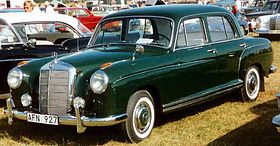 | |
| Overview | |
| Also called | 220a/220S/220SE |
| Production | 1954–1957 (W180) 1958–1961 (W128) |
| Layout | FR layout |
| Powertrain | |
| Engine | 2.2L I6 |
The W180 line debuted in 1954, and is the first lineup of "Ponton" models associated with the Mercedes-Benz S-Class. The W180 featured six-cylinder sedan, coupé, and convertible models, and was produced until 1957. The later W128 lineup, introduced in the mid-to-late 1950s, was the last to be associated with the "Ponton" name. It featured the 220a, 219 (W105), 220S, and 220SE models (sedan, coupé, and cabriolet) powered by a 2.2L straight-6, and came to ten. The "Ponton" designation referred to pontoon fenders, a stylistic feature on the W180/W128 models.
The "Ponton" lineup included four- and six-cylinder models, but only the six-cylinder W180 and W128 lines are considered part of the Mercedes-Benz S-Class chronology, as they were the most powerful "Ponton" versions available. Both "Ponton" models were Mercedes' first without a conventional frame, using a unitized body/frame construction.
"Fintail" (1959)
| W111/W112 | |
|---|---|
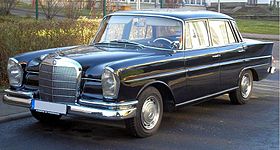 | |
| Overview | |
| Also called | 220/220S/220SE/230S/250SE/280SE/280SE 3.5 |
| Production | 1959–1968 (sedan) 1961–1971 (coupe and cabriolet) |
| Layout | FR layout |
| Powertrain | |
| Engine | 2.2 L I6 2.3 L I6 2.5 L I6 2.8 L I6 3.5 L V8 |
Mercedes Benz Fintail (German: Heckflosse) is a nickname given to certain Mercedes Benz vehicles which show American influences in design including the presence of tailfins. Though never officially designated as such (they were designated Peilstege, marking the end of the car in rear view mirror). The Fintail series replaced the Ponton series.
The exterior was designed for the European and North American markets. The body was modern and featured a characteristic tailfins that gave the models their nickname — the fintail (German: Heckflosse).
The W111 was a chassis code given to its top-range vehicles, including four-door sedans, produced from 1959 to 1968, and two-door coupes and cabriolets from 1961 to 1971. The W111, was initially attributed only to six-cylinder cars with 2.2-litre engines. The luxury version with big-block 3-litre engines were given the chassis code W112. The entry-level vehicles with four-cylinder engines were called W110. All three versions W110, W111, and W112, in both two- and four-door bodies, were built on an identical chassis.
W108 (1965)
| W108 & W109 | |
|---|---|
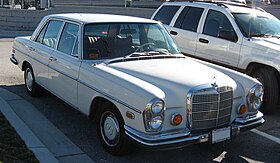 | |
| Overview | |
| Also called | 250S/SE/280S/SE & 300SE |
| Production | 1965–1972 |
| Layout | FR layout |
| Powertrain | |
| Engine | 2.5 L I6 2.8 L I6 3.0L I6 3.5 L V8 4.5 L V8 6.3 L V8 |
With "Fintails" being passé and dropped in favor of a look similar to the 800, the updated and larger W108/W109lines were introduced in 1965. With the W108/W109 series, the range received V8 power for the first time (from 1969). The W108 line launched with an initial lineup of straight-six powered models using the M129, 2.5-liter engine. The unusual high-displacement 300 SEL 6.3 V8 model was based on this body type. The W108 line, which included the 250S, 250SE, 280S 280SE and 280SEL (long-wheelbase) models, was larger than the Fintail models it replaced, and also eliminated the characteristic design feature of the previous model.
During this period, the designation S or SE was used for short-wheelbase models including 250S, 250SE, 280S, 280SE and 300SE. The "E" stands for the German word "Einspritzung" which was a reference to the vehicle being equipped with fuel injection for the engine. Vehicles without the E designation as part of the model number or nomenclature retained the carburetor setup. Long-wheelbase models (extended by 10 centimeters in the rear doors) were designated SEL (L= lang or long). Since the advent of the W108 series, the Mercedes-Benz S-Class has always included two wheelbase lengths, although not all wheelbases are sold in every country. The 300 SE and 300 SEL models were classified as W109 chassis and had front and rear air suspension compared to coil spring based rear suspension of W108 models. The more powerful 300SE and 300SEL models were the most luxurious versions of the W108 line, with available burl walnut interior trim, automatic transmission, and power windows.
First generation (1972–1980)
| W116 | |
|---|---|
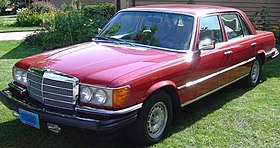 | |
| Overview | |
| Also called | 280S/SE/SEL, 350/450SE/SEL, 300SD |
| Production | 1972–1980 |
| Layout | FR layout |
| Powertrain | |
| Engine | 2.8 L I6 3.5 L V8 4.5 L V8 6.9 L V8 3.0 L I5 turbodiesel |
| Transmission | 3-speed automatic 4-speed automatic 5-speed manual |
In 1972, Mercedes-Benz introduced the W116 line, the first to be officially called the S-Class.[4] Produced from 1972 through 1980, the W116 series featured a four-wheel independent suspension and disc brakes. The 280, 350, and 450 (4.5L version) models featured SE and SEL versions. Production of the W116 totaled 473,035 units. This was a groundbreaking sedan for Mercedes-Benz, and for the first time in the company history, the car had an obvious, blatant and outward emphasis on safety placed above a pure styling viewpoint. The overall design incorporated numerous safety features developed from the "safety research vehicles" in the mid-to-late 1960s to the very early 1970s.
These safety features were all newly introduced passenger-car "firsts" on a production vehicle: padded door trim around the windows, heavily padded steering wheel (later to be replaced by an airbag with the Mercedes-Benz abbreviation of SRS standing for the English-language term Supplemental Restraint System), more comprehensive safety padding on the dashboard and around the interior, dual asymmetric windshield wipers, headrests with a center depression to locate the occupant's head in a more central position during a rear impact, a rain-water management system to improve visibility consisting of deep channels on both sides of the windshield and flowing into deeply channeled rain gutters, including similar designs on the side mirrors, rounded body shapes along the edges, such as the tops of the front fenders, etc., designed to ameliorate pedestrian injuries, ribbed rear taillamp lenses which would remain clearer of dirt on the recessed areas, an easy-to-access first aid kit stowed in a recessed compartment on the rear parcel shelf prominently labeled with the universally recognized "cross" symbol which represents "first aid", and several other subtle safety features related to both active and passive safety. The Mercedes Benz S-Class is a classic chauffeur driven car,[5] and has frequently been used as standard by car hire companies. It is comfortable and safe as well as elegant looking; ideal for drives across the countryside or high class transport on a night out.
Engines
With the W116 models, the V8-engines of the 350/450 SE/SEL models were now regular options. Due to the oil crisis, fuel efficiency was the major concern for the engineers, yet they still added also the high-performance, limited-production 450 SEL 6.9. This 8-cylinder model, affectionately referred to as simply "the 6.9", boasted the largest engine installed in a postwar Mercedes-Benz up to that time. Every 450 SEL 6.9 featured a self-leveling hydropneumatic suspension, and offered the ABSanti-lock braking system as an option from 1978 onwards. Also, in the United States and Canada only, Mercedes-Benz introduced the economical but powerful 3.0-liter 5-cylinder turbodiesel in 1978, sold as the 300SD.
Second generation W126 (1979–1991)
| W126 | |
|---|---|
 | |
| Overview | |
| Also called | 260/280/300/380SE/SEL, 420/500/560SE/SEL/SEC, 300/350SD/SDL |
| Production | December 1979 – April 1991 |
| Layout | FR layout |
| Powertrain | |
| Engine | 2.6 L straight-six 2.8 L straight-six 3.0 L straight-six 3.5 L straight-six 3.8 L V8 4.2 L V8 5.0 L V8 5.6 L V8 3.0 L 5-cylinder turbodiesel 3.0 L 6-cylinder turbodiesel 3.5 L 6-cylinder turbodiesel |
| Transmission | 4-speed automatic 5-speed manual |
The W126 series premiered in late 1979 as an 1980 model, and in March 1980 as an 1981 model in the USA and Australia replacing the W116 line. The W126 line featured improved aerodynamics and enlarged aluminum engine blocks. In 1981, the W126 S-Class won the Wheels magazine (Australia) Car of the Year award. The W126 was manufactured from 1979 through 1991 with a mid-cycle update. Coupé models based on the S-Class were reintroduced with the W126 (380/500 SEC). Total sales of the W126 S-Class sedans reached 818,036 units, with an additional 74,060 coupes sold.
In 1981, the W126 introduced a driver side airbag, as patented by Mercedes-Benz in 1971, as well as the passenger side airbags (in 1988), seat-belt pretensioners, and traction control. The interior featured additional courtesy and reading lamps, along with heated seats and a more advanced climate control system. A four-speed automatic transmission was standard.
Although the top of range Mercedes-Benz 450SEL 6.9 of the previous generation was not directly replaced, the W126 carried forward thehydropneumatic suspension of the 6.9 as an option on the 500SEL. A new cruise control system was offered as well. Succeeding the roadster basedcoupes, the W126 introduced a two-door variant, the SEC coupé. The W126 S-Class received a mid-cycle update in 1986 with exterior modifications and engine upgrades occurred.
Engines[edit]
Powerplants on the W126 S-Class included straight-6 and V8 engines. Most sales came from the diesel model in Europe and straight-six models in theUnited States, although the V8 models were praised by contemporaryjournalists. During the W126 mid-cycle update in 1986, both the straight-6 and V8 engines were upgraded in several models to different displacement levels (six-cylinder upgraded from 2.8 L to 3.0 L, eight-cylinder upgraded from 3.8 L to 4.2 L, and 5.0 L to 5.6 L).
Third generation W140/C140 (1991–1998)
| W140 | |
|---|---|
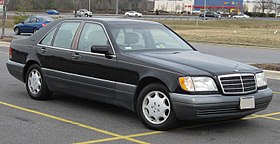 | |
| Overview | |
| Also called | 300SE/SEL, 400/500/600SEL, 500/600SEC, 300SDL, 350SDL (1991-1993) S280/300/320/320L/420/420L/500/500L/600/600L (1993-1998) |
| Production | April 1991 – August 1998 |
| Layout | FR layout |
| Powertrain | |
| Engine | 2.8 L 197 hp (147 kW) I6 3.2 L 228 hp (170 kW) I6 4.2 L 275 hp (205 kW) V8 5.0 L 330 hp (250 kW) V8 6.0 L 408 hp (304 kW) V12 M120 (1991–1993) 6.0 L 389 hp (290 kW) V12 M120 (1994–1999) 3.0 L Turbodiesel 177 hp (132 kW) I6 3.5 L Turbodiesel 148 hp (110 kW) I6 |
| Transmission | 4-speed automatic 5-speed automatic 5-speed manual |
In 1991, the W140 series replaced the W126 line with the first production model assembled on August 6 of that year.[citation needed] The W140 grew in proportions and featured two wheelbase lengths and a shorter-wheelbase W140 coupé. Production totalled 432,732 units.[citation needed]
The W140 cost 25% more than the W126 it replaced and featured double-pane window glazing, self-closing boot lid and doors, electric windows with a jam-protection feature (lowering when encountering an obstruction), rear-parking markers in the US (which appeared on the rear wings when in reverse), and a heating system which emitted warm air while residual energy was available after the engine was turned off.
In 1993, Mercedes-Benz model nomenclature was rationalized, with the SE/SEL/SEC cars becoming the S-Class and alphanumerical designations inverted (e.g. the both 500SE and 500SEL became S500 regardless of wheelbase length). In 1995, the W140 received a minor facelift featuring clear turn signal indicator lenses on the front and rear as well as headlamps fitted with separate low- and high-beam reflectors for the US market. Following the mid-year facelift, the W140 coupé and sedan (Saloon) featured Electronic Stability Control.
Fourth generation W220 (1998–2005)
| W220 | |
|---|---|
 | |
| Overview | |
| Also called | S280, S320, S320 CDI, S400 CDI, S350, S430, S500, S600, S55, S63, S65 |
| Production | August 1998 – July 2005 |
| Layout | Front engine, rear-wheel drive orfour-wheel drive |
| Powertrain | |
| Engine | 2.8 L 204 hp (152 kW) V6 3.2 L 224 hp (167 kW) V6 3.2 L 197 hp (147 kW) I6 diesel 3.2 L 204 hp (152 kW) I6 diesel 3.7 L 245 hp (183 kW) V6 4.0 L 250 hp (190 kW) V8 diesel 4.0 L 260 hp (190 kW) V8 diesel 4.3 L 279 hp (208 kW) V8 5.0 L 306 hp (228 kW) V8 5.4 L 493 hp (368 kW) V8 5.8 L 367 hp (274 kW) V12 5.5 L 493 hp (368 kW) V12 6.3 L 444 hp (331 kW) V12 6.0 L 604 hp (450 kW) V12 |
| Transmission | 5-speed automatic and 7-speed automatic (7G-Tronic) |
In July 1998, the W220 was introduced. The W220 S-Class was completely restyled, with a body that was slightly smaller and lighter than its predecessor. Unlike its predecessor, the W220 was not the first model to feature the company's new design theme for the next generation of Mercedes-Benz. This honor was given to the A-Class when it launched in 1997. The new S-Class incorporated the new styling cues first introduced on the Mk I A-Class the year before (for example, the dashboard carried over the new styling details first seen in the A-Class), with a renewed focus on elegance and style in a more rounded shape compared to the preceding W140. Despite being smaller, the W220 S-Class offered more interior space than the W140. Production of the W220 S-Class totaled 485,000 units, slightly more than the production totals from the W140. The W220 was produced in a sedan version only.[6]
As with each new S-Class, the W220 brought in innovations such as Airmatic air suspension and Active Ventilated Seats (which used miniature fans in the seats to move air through perforations). A navigation system with center console-mounted screen display was introduced, along with the COMAND input control system. Other options included keyless entry and ignition, a radar-controlled Distronic cruise control system and a cylinder shut-off system called Active Cylinder Control. The 4MATIC all-wheel drive system was introduced to the North America market S-Class for 2003, complementing the traditional rear-wheel drive configurations.
Engines
The W220 was available with more engine options than the W126 or W140. The range started with smaller 3.2L 224 hp (167 kW) V6 motor, which was superseded by an enlarged 3.7 L 245 hp (183 kW) V6 in the S350. The S430 was powered by a 4.3 L 279 hp (208 kW) V8 and the S500 was powered by a 5.0 L 306 hp (228 kW) V8. The S55 AMG was outfitted with a supercharged 5.4 L 493 hp (368 kW) V8 motor, the S55 AMG 2000/2001 was outfitted with the naturally aspirated 5.4 L 360 hp (270 kW) V8 motor. The S600 was outfitted with a 5.5 L 493 hp (368 kW) V12 twin turbo engine, the S600 2000/2001 was outfitted with the naturally aspirated 5.8 L 367 hp (274 kW) V12 engine.
Fifth generation W221 (2005–2013)
| W221 | |
|---|---|
 | |
| Overview | |
| Also called | S250 CDI, S300, S350 (BlueEFFICIENCY, BlueTEC), S400 HYBRID, S450, S550(500), S600, S320/S420 CDI, S63, S65 |
| Production | 2005–2013 |
| Model years | 2006–2013 (Europe) 2007–2014 |
| Body and chassis | |
| Layout | Front engine, rear-wheel drive orfour-wheel drive |
| Related | Mercedes-Benz CL-Class |
| Powertrain | |
| Engine |
2.1 L diesel 204 hp (152 kW) I4
6.2 L AMG 525 hp (391 kW) V83.0 L diesel 258 hp (192 kW) V6 3.5 L 306 hp (228 kW) V6 3.5 L hybrid 295 hp (220 kW) V6 4.7 L 335 hp (250 kW) V8 4.7 L 435 hp (324 kW) V8 5.5 L 382 hp (285 kW) V8 5.5 L 510 hp (380 kW) V12 5.5 L AMG 536 hp (400 kW) V8 6.0 L AMG 621 hp (463 kW) V12 |
| Transmission | 7-speed (5-speed on S65 & S600)automatic |
| Dimensions | |
| Wheelbase | SWB: 3035 mm LWB: 3165 mm |
The all-new W221 was introduced in the autumn of 2005 at the Frankfurt International Motor Show, with sales starting in autumn of 2005 and export to other markets beginning in 2006. The W221 S-Class made its North American premiere at the 2006 North American International Auto Show in January. The latest S-Class is slightly larger in all dimensions than its predecessor, and it features three newly developed engines with up to 26% power increase. The interior is completely new, all materials have been upgraded and make for a more luxurious ride, and the center console transmission gear lever has been replaced with a column-mounted shifter. New technological features on the W221 include an infrared Night View Assist feature and the latest Mercedes-Benz pre-collision system. The W221 features sharper exterior styling (most notably wide fender arcs) and technological improvements. The W221 is the second consecutive generation of the S-Class to be solely produced in a sedan body style.
Models sold in North America are the S450 (2008– , SWB and Canada only), S400 Hybrid (2010– ), S350 Bluetec 4MATIC (2012- ), S550, S600, S63 AMG and S65 AMG; other models to be sold outside North America include the S280, S350, S300, S420 CDI and S320 CDI. The first W221 model released in North America and Japan was the S550 (called S500 outside North America and Japan), with the S600 arriving in the following spring.[12][13] Mercedes Benz Mexico also produces a police spec model of the S-600, the S-600P. The S-600P is similar to the standard S-600 but is equipped with the dual turbo charged V-12 engine of the S65 AMG and includes police lights, siren, run-flat tires, a gun mount, a Lanix computer station integrated with the host police network, optional prisoner cage and restraint seats, and level B6/B7 armoring. The S-600P is only built in Mexico and only comes in long-wheelbase version. The Mexican government uses S-600P's mainly for transporting important figures, but several police departments in wealthier cities in the country use them as patrol vehicles, as does the Mexican Federal Police in limited numbers. A small number of S-600P were purchased by the police department of Guangzhou, China for protection of key government figures.
Sixth generation W222/C217 (2013–present)
| W222/C217 | |
|---|---|
 | |
| Overview | |
| Production | 2013–present |
| Model years | 2014– |
| Layout | Front engine, rear-wheel drive orfour-wheel drive |
| Powertrain | |
| Transmission | 7-speed automatic |
| Dimensions | |
| Wheelbase | SWB: 3,035 mm (119.5 in) LWB: 3,165 mm (124.6 in) |
| Length | SWB: 5,116 mm (201.4 in) LWB: 5,246 mm (206.5 in)[20] |
| Width | 1,899 mm (74.8 in)[20] |
| Height | 1,496 mm (58.9 in)[20] |
Officially unveiled in May 2013, the newest S-Class has a more streamlined appearance than the outgoing model. Some interesting features include a large front grille inspired by the F700 Concept car and LED lights used exclusively inside and out - a first in the automotive industry.
Two strong converging character lines give the flanks a more sculpted look, while integrated exhaust tips and a large glass roof (likely optional) highlight the design. Inside, almost every surface is covered by a 'luxury' material - everything that looks like leather is genuine leather and metal is used rather than any plastic alternative. The instrument cluster consists entirely of two widescreen (30.5 cm diagonal) LCD displays with animated graphics. A 'Head-Up' display and gesture responsive touch pad became options in early 2014.
The W222 debuts the available Magic Body Control, consisting of windshield mounted stereo cameras that can 'read' the road ahead (Road Surface Scan) and communicate with the Active Body Control suspension to ready it for an uneven road surface. Initially only available on 8-cylinder models and above, Magic Ride Control attempts to isolate the car's body by predicting rather than reacting to broken pavement and speed humps.
Available luxury appointments over and above what was offered in the W221 include a choice of massage type for each seat occupant (the W221 offered various intensities of a single massage type) and two levels of premium audio from luxury German brand, Burmester.


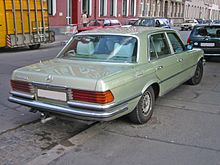



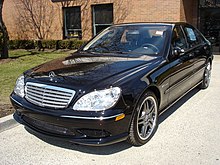

No comments:
Post a Comment